Y. Huang
Flexible variable selection in the presence of missing data
Feb 25, 2022



Abstract:In many applications, it is of interest to identify a parsimonious set of features, or panel, from multiple candidates that achieves a desired level of performance in predicting a response. This task is often complicated in practice by missing data arising from the sampling design or other random mechanisms. Most recent work on variable selection in missing data contexts relies in some part on a finite-dimensional statistical model (e.g., a generalized or penalized linear model). In cases where this model is misspecified, the selected variables may not all be truly scientifically relevant and can result in panels with suboptimal classification performance. To address this limitation, we propose several nonparametric variable selection algorithms combined with multiple imputation to develop flexible panels in the presence of missing-at-random data. We outline strategies based on the proposed algorithms that achieve control of commonly used error rates. Through simulations, we show that our proposals have good operating characteristics and result in panels with higher classification performance compared to several existing penalized regression approaches. Finally, we use the proposed methods to develop biomarker panels for separating pancreatic cysts with differing malignancy potential in a setting where complicated missingness in the biomarkers arose due to limited specimen volumes.
Joint User Scheduling and Beamforming Design for Multiuser MISO Downlink Systems
Dec 03, 2021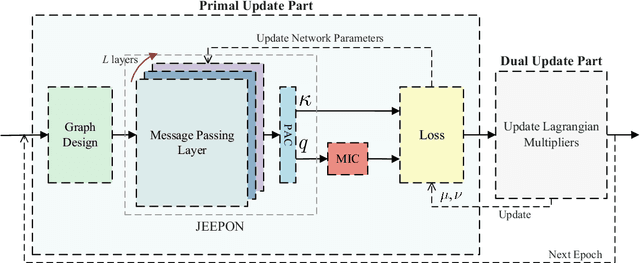
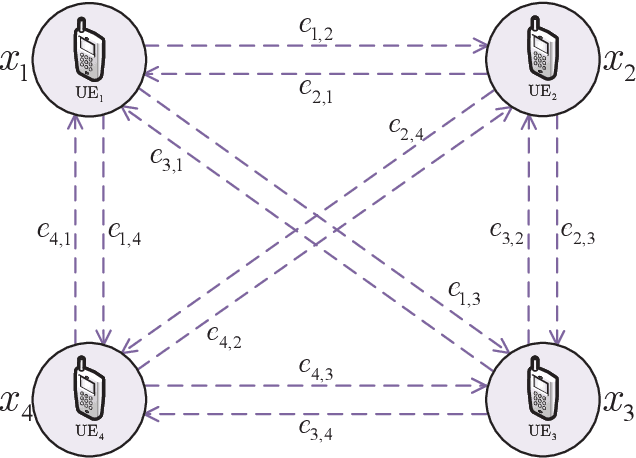
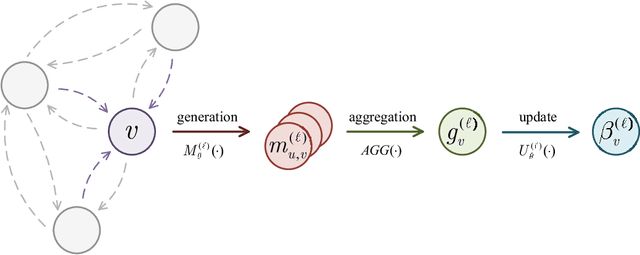
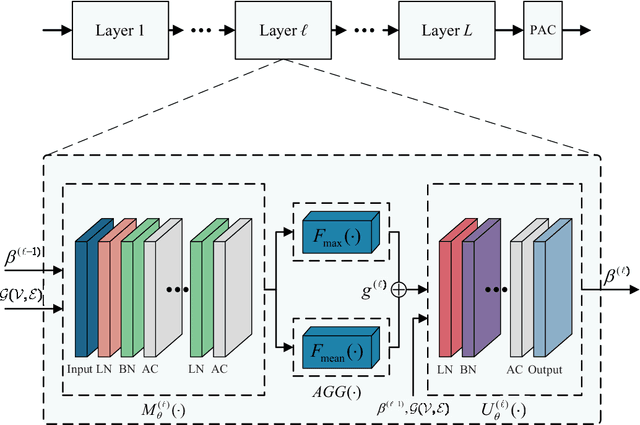
Abstract:In multiuser communication systems, user scheduling and beamforming design are two fundamental problems, which are usually investigated separately in the existing literature. In this work, we focus on the joint optimization of user scheduling and beamforming design with the goal of maximizing the set cardinality of scheduled users. Observing that this problem is computationally challenging due to the non-convex objective function and coupled constraints in continuous and binary variables. To tackle these difficulties, we first propose an iterative optimization algorithm (IOA) relying on the successive convex approximation and uplink-downlink duality theory. Then, motivated by IOA and graph neural networks, a joint user scheduling and power allocation network (JEEPON) is developed to address the investigated problem in an unsupervised manner. The effectiveness of IOA and JEEPON is verified by various numerical results, and the latter achieves a close performance but lower complexity compared with IOA and the greedy-based algorithm. Remarkably, the proposed JEEPON is also competitive in terms of the generalization ability in dynamic wireless network scenarios.
GBLinks: GNN-Based Beam Selection and Link Activation for Ultra-dense D2D mmWave Networks
Jul 28, 2021
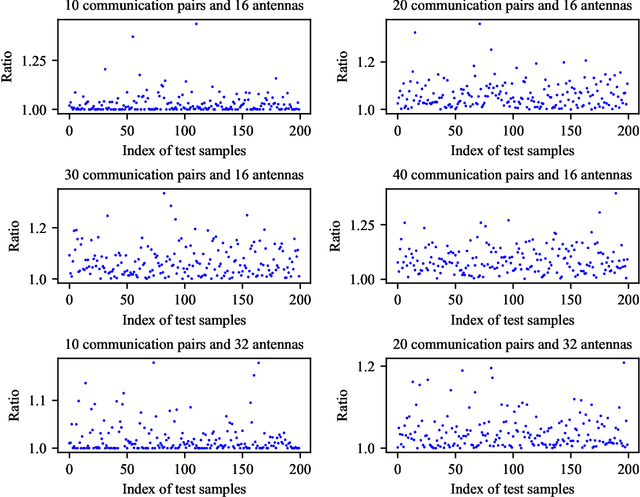


Abstract:In this paper, we consider the problem of joint beam selection and link activation across a set of communication pairs to effectively control the interference between communication pairs via inactivating part communication pairs in ultra-dense device-to-device (D2D) mmWave communication networks. The resulting optimization problem is formulated as an integer programming problem that is nonconvex and NP-hard problem. Consequently, the global optimal solution, even the local optimal solution, cannot be generally obtained. To overcome this challenge, this paper resorts to design a deep learning architecture based on graph neural network to finish the joint beam selection and link activation, with taking the network topology information into account. Meanwhile, we present an unsupervised Lagrangian dual learning framework to train the parameters of GBLinks model. Numerical results show that the proposed GBLinks model can converges to a stable point with the number of iterations increases, in terms of the sum rate. Furthermore, the GBLinks model can reach near-optimal solution through comparing with the exhaustive search scheme in small-scale ultra-dense D2D mmWave communication networks and outperforms GreedyNoSched and the SCA-based method. It also shows that the GBLinks model can generalize to varying scales and densities of ultra-dense D2D mmWave communication networks.
A Robust Deep Learning Approach for Automatic Seizure Detection
Dec 17, 2018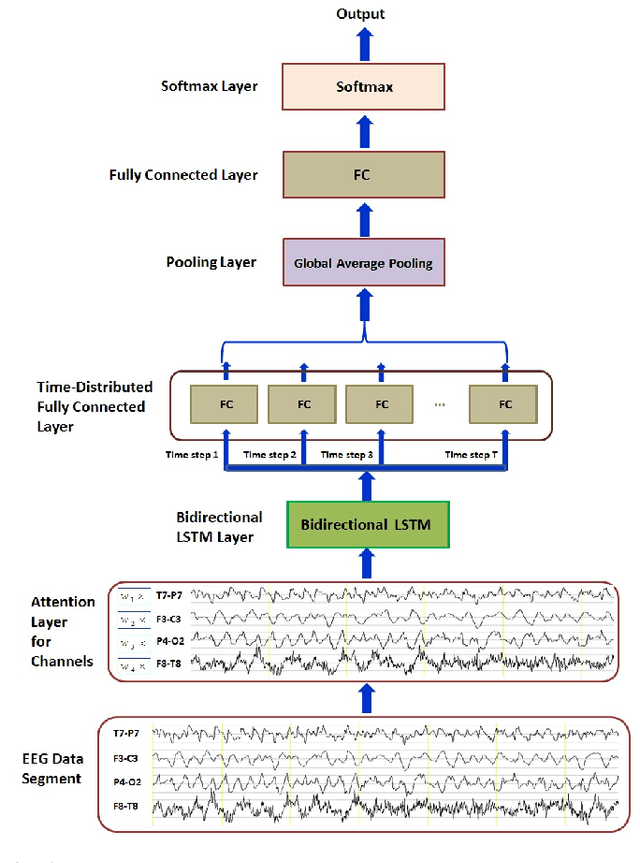

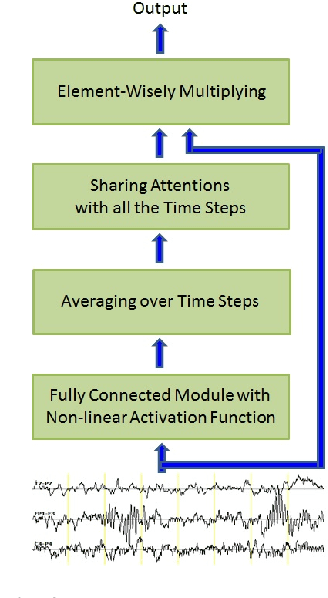

Abstract:Detecting epileptic seizure through analysis of the electroencephalography (EEG) signal becomes a standard method for the diagnosis of epilepsy. In a manual way, monitoring of long term EEG is tedious and error prone. Therefore, a reliable automatic seizure detection method is desirable. A critical challenge to automatic seizure detection is that seizure morphologies exhibit considerable variabilities. In order to capture essential seizure patterns, this paper leverages an attention mechanism and a bidirectional long short-term memory (BiLSTM) model to exploit both spatially and temporally discriminating features and account for seizure variabilities. The attention mechanism is to capture spatial features more effectively according to the contributions of brain areas to seizures. The BiLSTM model is to extract more discriminating temporal features in the forward and the backward directions. By accounting for both spatial and temporal variations of seizures, the proposed method is more robust across subjects. The testing results over the noisy real data of CHB-MIT show that the proposed method outperforms the current state-of-the-art methods. In both mixing-patients and cross-patient experiments, the average sensitivity and specificity are both higher while their corresponding standard deviations are lower than the methods in comparison.
 Add to Chrome
Add to Chrome Add to Firefox
Add to Firefox Add to Edge
Add to Edge